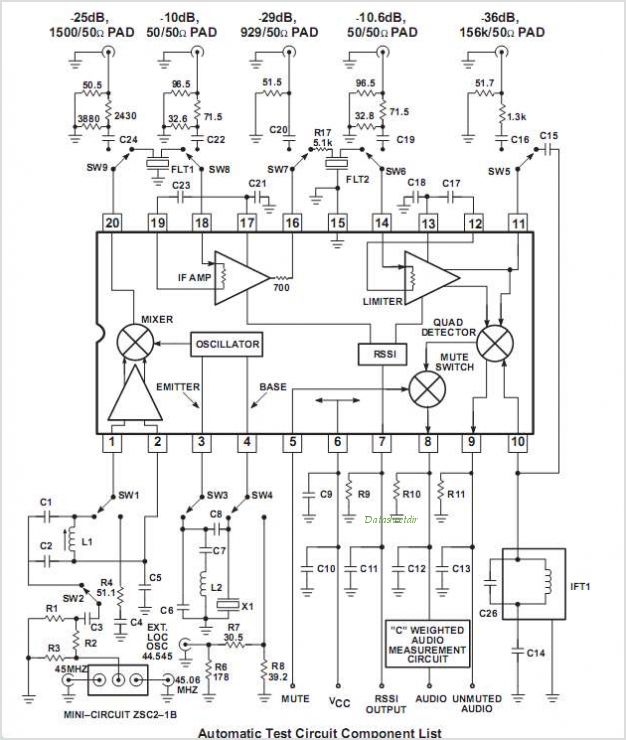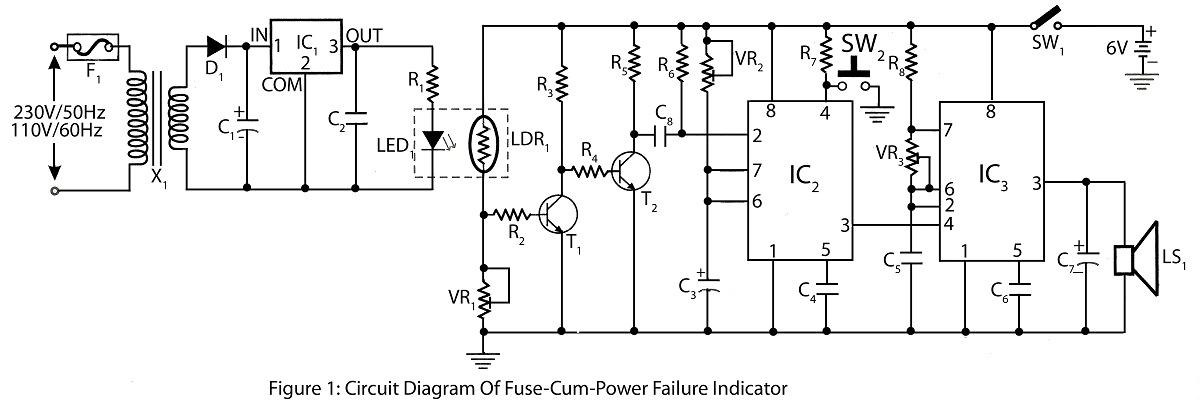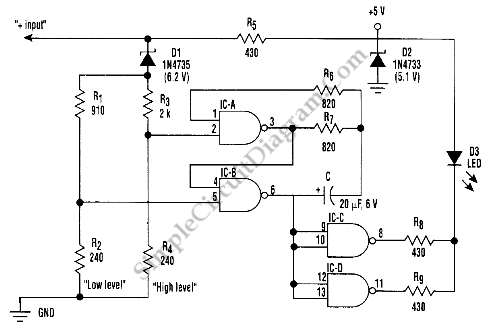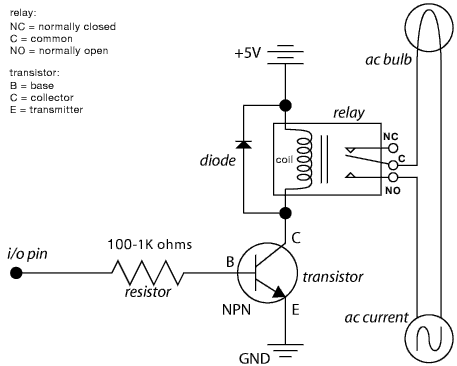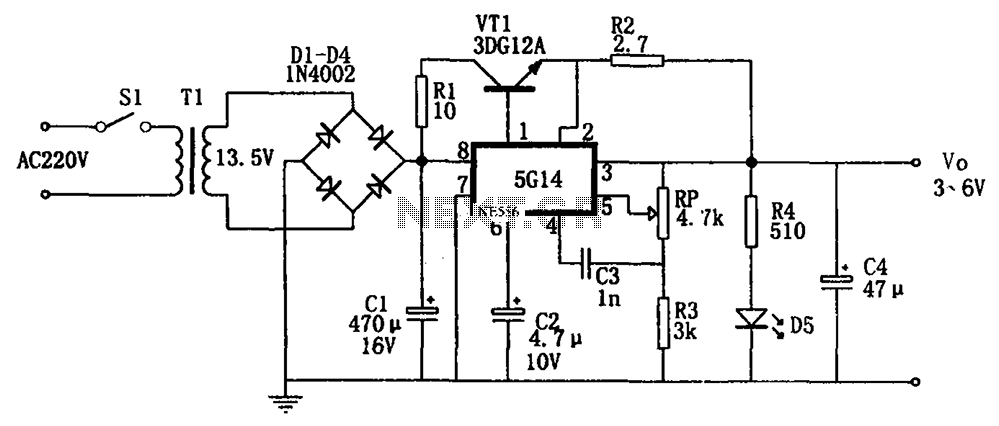
usb power socket with indicator
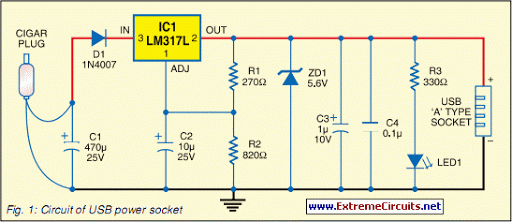
Nearly all modern computers are equipped with logic blocks that facilitate the implementation of a USB port. A USB port can deliver over 100 mA of continuous current at 5V to peripherals connected to the bus. Therefore, it serves effectively for powering small electronic devices that operate on 5V DC. Currently, many handheld devices, such as portable reading lamps, utilize the USB port to recharge their internal battery packs through internal circuitry. Typically, these devices require a 5V DC supply with a current of 100 mA to meet their power demands. The circuit illustrated in Figure 1 depicts a versatile USB power socket designed to safely convert a 12V battery voltage into a stable 5V output. This circuit allows for the power and recharging of any USB-powered device using the in-dash board cigarette lighter socket of a vehicle. The DC supply from the cigarette lighter socket is directed to an adjustable three-pin regulator, the LM317L (IC1). Capacitor C1 acts as a buffer to stabilize the input supply. Resistors R1 and R2 are used to regulate the output of IC1 to a steady 5V, which is accessible at the A-type female USB socket. A red LED (LED1) indicates the output status, while the zener diode (ZD1) provides protection against high voltage. The circuit should be assembled on a general-purpose PCB and enclosed in a slim plastic cabinet, incorporating the indicator and USB socket. It is crucial to ensure the correct polarity of the supply when wiring the USB outlet. For the interconnection between the cigarette plug pin and the device, a long coil cord should be utilized as shown in Figure 2. The pin configuration for the LM317L is provided in Figure 3.
The described circuit serves as a practical solution for powering and recharging USB devices from a vehicle's cigarette lighter socket. The use of the LM317L voltage regulator is essential for achieving the desired output voltage and current, ensuring compatibility with various USB-powered devices. The configuration of resistors R1 and R2 is critical, as they determine the output voltage based on the formula provided in the LM317L datasheet. The stability of the output voltage is enhanced by the inclusion of capacitor C1, which mitigates fluctuations in the input voltage that could affect performance.
Incorporating a red LED indicator allows users to easily ascertain whether the circuit is operational, providing a visual cue that the USB port is active and ready to charge devices. The addition of the zener diode (ZD1) is a vital safety feature, protecting the circuit from potential overvoltage conditions that could damage connected devices.
When assembling the circuit on a general-purpose PCB, attention should be paid to layout considerations, ensuring that the components are placed to minimize interference and maintain a compact design. The enclosure should be designed to allow for adequate ventilation to prevent overheating, especially during prolonged use.
Overall, this USB power socket circuit exemplifies a versatile and efficient method for utilizing existing vehicle power sources to charge and power portable electronic devices, making it a valuable addition to any automotive accessory lineup. Proper implementation and attention to detail during assembly will result in a reliable and functional product.Today, almost all computers contain logic blocks for implementing a USB port. A USB port, in practice, is capable of delivering more than 100 mA of continuous current at 5V to the peripherals that are connected to the bus. So a USB port can be used, without any trouble, for powering 5V DC operated tiny electronic gadgets. Nowadays, many handheld d evices (for instance, portable reading lamps) utilise this facility of the USB port to recharge their built-in battery pack with the help of an internal circuitry. Usually 5V DC, 100mA current is required to satisfy the input power demand. Fig. 1 shows the circuit of a versatile USB power socket that safely converts the 12V battery voltage into stable 5V.
This circuit makes it possible to power/recharge any USB power-operated device, using in-dash board cigar lighter socket of your car. The DC supply available from the cigar lighter socket is fed to an adjustable, three-pin regulator LM317L (IC1).
Capacitor C1 buffers any disorder in the input supply. Resistors R1 and R2 regulate the output of IC1 to steady 5V, which is available at the A` type female USB socket. Red LED1 indicates the output status and zener diode ZD1 acts as a protector against high voltage. Assemble the circuit on a general-purpose PCB and enclose in a slim plastic cabinet along with the indicator and USB socket.
While wiring the USB outlet, ensure correct polarity of the supply. For interconnection between the cigar plug pin and the device, use a long coil cord as shown in Fig. 2. Pin configuration of LM317L is shown in Fig. 3. 🔗 External reference
The described circuit serves as a practical solution for powering and recharging USB devices from a vehicle's cigarette lighter socket. The use of the LM317L voltage regulator is essential for achieving the desired output voltage and current, ensuring compatibility with various USB-powered devices. The configuration of resistors R1 and R2 is critical, as they determine the output voltage based on the formula provided in the LM317L datasheet. The stability of the output voltage is enhanced by the inclusion of capacitor C1, which mitigates fluctuations in the input voltage that could affect performance.
Incorporating a red LED indicator allows users to easily ascertain whether the circuit is operational, providing a visual cue that the USB port is active and ready to charge devices. The addition of the zener diode (ZD1) is a vital safety feature, protecting the circuit from potential overvoltage conditions that could damage connected devices.
When assembling the circuit on a general-purpose PCB, attention should be paid to layout considerations, ensuring that the components are placed to minimize interference and maintain a compact design. The enclosure should be designed to allow for adequate ventilation to prevent overheating, especially during prolonged use.
Overall, this USB power socket circuit exemplifies a versatile and efficient method for utilizing existing vehicle power sources to charge and power portable electronic devices, making it a valuable addition to any automotive accessory lineup. Proper implementation and attention to detail during assembly will result in a reliable and functional product.Today, almost all computers contain logic blocks for implementing a USB port. A USB port, in practice, is capable of delivering more than 100 mA of continuous current at 5V to the peripherals that are connected to the bus. So a USB port can be used, without any trouble, for powering 5V DC operated tiny electronic gadgets. Nowadays, many handheld d evices (for instance, portable reading lamps) utilise this facility of the USB port to recharge their built-in battery pack with the help of an internal circuitry. Usually 5V DC, 100mA current is required to satisfy the input power demand. Fig. 1 shows the circuit of a versatile USB power socket that safely converts the 12V battery voltage into stable 5V.
This circuit makes it possible to power/recharge any USB power-operated device, using in-dash board cigar lighter socket of your car. The DC supply available from the cigar lighter socket is fed to an adjustable, three-pin regulator LM317L (IC1).
Capacitor C1 buffers any disorder in the input supply. Resistors R1 and R2 regulate the output of IC1 to steady 5V, which is available at the A` type female USB socket. Red LED1 indicates the output status and zener diode ZD1 acts as a protector against high voltage. Assemble the circuit on a general-purpose PCB and enclose in a slim plastic cabinet along with the indicator and USB socket.
While wiring the USB outlet, ensure correct polarity of the supply. For interconnection between the cigar plug pin and the device, use a long coil cord as shown in Fig. 2. Pin configuration of LM317L is shown in Fig. 3. 🔗 External reference
